|
Advantech SOM-7565
COM Express functionality and configurability in a tiny Intel Atom N2600-based module
(by Conrad H. Blickenstorfer)
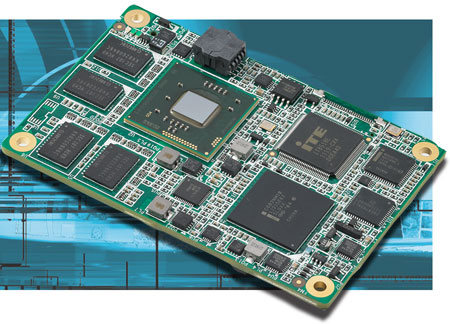 COM stands for Computer-On-Module and is a type of highly integrated PC commonly used in various embedded systems projects. Unlike regular PC motherboards with their numerous wires and cables and connectors, COM boards simply plug into a project-specific carrier board. In essence, by using COM modules, systems integrators can treat entire computers like mere components and concentrate on the specific aspects of their project instead, saving cost and development time. COM stands for Computer-On-Module and is a type of highly integrated PC commonly used in various embedded systems projects. Unlike regular PC motherboards with their numerous wires and cables and connectors, COM boards simply plug into a project-specific carrier board. In essence, by using COM modules, systems integrators can treat entire computers like mere components and concentrate on the specific aspects of their project instead, saving cost and development time.
Although COM is a precisely defined standard administered by the PCI Industrial Computer Manufacturers Group (PICMG), it evolved over time, with COM-Express the current implementation. COM modules also come in various sizes, those being Mini (55 x 84 mm), Compact (95 x 95 mm), Basic (95 x 125 mm), and Extended (110 x 155 mm). In addition to the different sizes, there are also different pin-outs on either a single or a double connector. The type of pin-out defines the type and number of interfaces available. The Advantech SOM-7565 reviewed here is a COM Express Mini Module and uses what is referred to as a Type 10 AB connector.
What is the Advantech SOM-7565 for?
In short, it's for projects where the smallest possible size matters. What you get with a COM Express Mini module is an entire x86-based computer on a tiny board measuring just 3.3 x 2.17 inches (84 x 55 mm). The picture below illustrates how that compares to an Apple iPhone 4. That said, the COM module itself will only be part of a package that'll also include the project-specific carrier board, a heat spreader, and whatever I/O ports and connectors are required. Still, the exceedingly compact size of the Mini module allows for very compact and even for handheld applications.
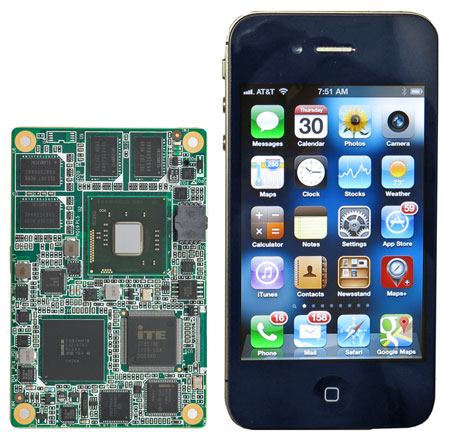 In terms of performance and features, most current COM Express Mini modules use Intel Atom processors. And as for now, Mini modules are either Type 1 or Type 10 single connector pin-outs (for pin-out details, see here). In terms of performance and features, most current COM Express Mini modules use Intel Atom processors. And as for now, Mini modules are either Type 1 or Type 10 single connector pin-outs (for pin-out details, see here).
Type 1 provides up to 6 PCI Express lanes, 4 SATA ports, LAN, 8 USB 2.0, and VGA and LVDS as display interfaces.
Type 10 is very similar, but uses some of the PCIe and SATA pins, the VGA and TV-out pins, as well as the second LVDS channels in favor of SDVO (Serial Digital Video Out) via a DDI display interface.
So what that means in practice is that Type 10 pin-out boards such as the Advantech SOM-7565 can support dual displays, one through LVDS, and a second through a shared port. In the SOM-7565, that shared port supports HDMI, DVI, and DisplayPort.
For testing, Advantech had sent us one of their SOM-DB5800 development boards that served as a carrier board for the Type 10 pin-out SOM-7565, and also a SOM-EA20 DDI riser board that provided up to three HDMI or DisplayPort interfaces. A total of no fewer than 17 switch blocks and three jumpers allowed precise configuration of the three DisplayPort and three HDMI connectors. Just to demonstrate the great flexibility of the development board, Advantech also sent along a SOM-EA10 PCIe riser that provided four PCIe x1 connector on the riser board that plugged into the development boards PCIe x4 slot.
Below are pictures of the SOM-EA20 (left) and EA10 (right) riser boards. This is just an example of the division of labor afforded by the COM module approach where developers and system integrators do not have to worry about designing CPU boards and can instead concentrate on the specific I/O requirements of the projects they are working on.
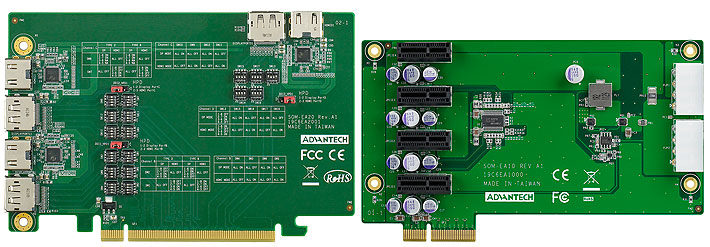
Intel Atom N2600 processor
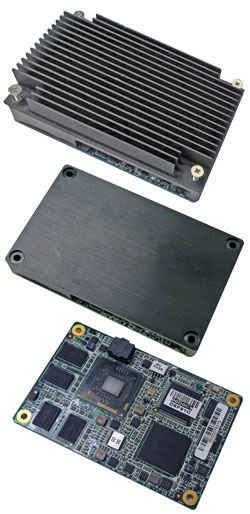 As far as performance goes, the small size and intended purpose of COM Express Mini modules go hand-in-hand with the targeted performance and low TDP of Intel Atom processors. And for the SOM-7565, Advantech selected the Atom N2600, which has a lot going for itself as, in our opinion, one of the best overall Atom processors. As far as performance goes, the small size and intended purpose of COM Express Mini modules go hand-in-hand with the targeted performance and low TDP of Intel Atom processors. And for the SOM-7565, Advantech selected the Atom N2600, which has a lot going for itself as, in our opinion, one of the best overall Atom processors.
Initially conceived as sort of a third generation of "netbook" processor, the N2600 remedied a lot of the performance issues of earlier Atom chip designs. It's the first Atom family to use 32nm process technology instead of the older 45nm, making for smaller, more efficient packages. All members of that "Cedarview" processor family are dual-core systems whereas before only desktop-oriented versions had two cores. Graphics performance benefits from a different design and much faster clock speed, resulting in Intel claims of 2X graphics performance compared to the second generation Atoms. And integrated hardware-accelerated video decoding finally enabled smooth full HD (up to 1080p) video playback.
So the N2600 is a competent dual-core design with twice the L2 cache, twice the graphics clock speed, faster DDR3 memory, and a maximum thermal design power of just 3.5 watts, considerably less than the 5.5 watts of the predecessor Atom N450. The complementing Intel NM10 Express chipset is miserly as well, with a TDP of just 2.1 watts, making for a combined CPU/chipset maximum draw of just 5.6 watts. In its N2600 promo materials, Intel predicted "up to 10 hours of battery life on portable devices."
That said, even the low combined maximum of 5.6 watts needs to be dissipated quickly and efficiently, and especially so in embedded designs where utmost reliability is of primary concern. The SOM-7565 doesn't need a fan, but our review unit did come with a substantial 2-part heat spreader/cooling fin block to address any thermal issues. The image to the right shows the bare SOM-7565 board, the board with its heat spreader, and, on top, the whole assembly with cooling fins.
We did run our entire standard performance benchmarks (PassMark and CrystalMark), and the results were quite impressive. The test setup's 5400rpm Seagate hard disk is a decent and economical performer, but for projects where speed matters we'd probably opt for some type of solid state disk. Below are the results of select CrystalMark mark tests that exercise the CPU and memory. For comparison we added the benchmark numbers of some other Advantech products we've tested in the past:
PERFORMANCE COMPARISON
CRYSTALMARK 2004R3
|
Atom N2600
|
Core i7-620LE
|
Core 2 Duo T7400
|
Core Duo L2400
|
Atom N270
|
Atom Z530
|
|
Clock speed
|
1.60GHz
|
2.00GHz
|
2.16GHz
|
1.66GHz
|
1.6GHz
|
1.6GHz
|
|
TDP
|
3.5 watts
|
18 watts
|
34 watts
|
15 watts
|
2.5 watts
|
2.3 watts
|
|
Tested in Advantech:
|
SOM-7565
|
SOM-5788
|
PPC-157T
|
ARK-3399
|
SOM-5761
|
SOM-6760
|
|
ALU
|
10,699
|
31,419
|
19,311
|
12,971
|
5,413
|
5,376
|
|
FPU
|
8,307
|
35,007
|
22,560
|
15,353
|
4,726
|
4,667
|
|
MEM
|
6,753
|
23,251
|
10,867
|
6,407
|
4,172
|
3,667
|
The results are as expected. Users can expect roughly twice the performance from this N2600 setup versus what is possible with boards powered by older Atom processors. In the same respect, Atoms are low power, economy processors that do not come close to offering Intel Core processor levels of performance, even that of older Core generations. That said, the SOM-7565 subjectively felt considerably faster than what the benchmarks suggest, and a fast SSD would make it quicker yet.
To demonstrate how it all fits together, below is a schematic of the Advantech SOM-7565:
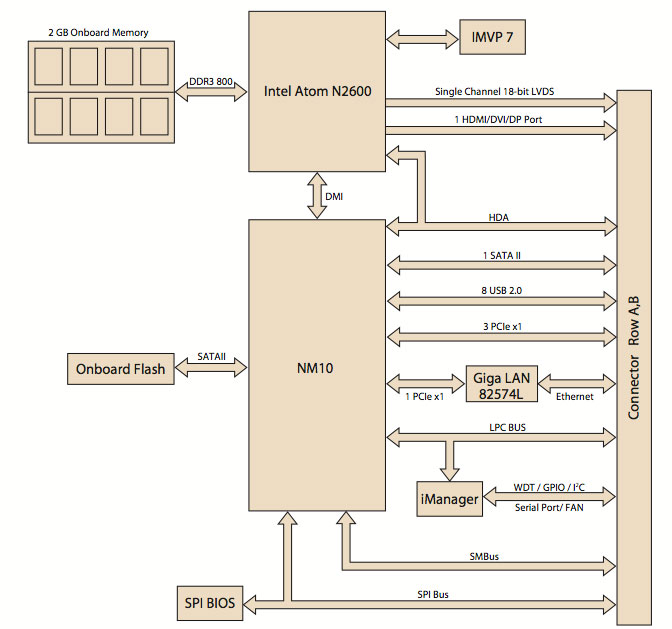
Computer modules like the Advantech SOM-7565 address very different markets from what we usually see here at RuggedPCReview.com. But there are also a lot of commonalities: embedded systems components are industrial-grade, reliable, and hugely configurable, just like the pre-built mobile rugged systems we primarily test and review. The very concept of separating the electronic engine at the core from the exterior functionality and connectivity is quite attractive, and something that designers of rugged tablets and notebooks certainly wouldn't mind having, given Intel's rapid-fire introduction of new chip generations and technologies.
As is, the SOM-7565 COM Express Mini module is just one of Advantech's almost endless roster of boards and components in numerous form factors. Each addresses slightly different issues and contains different technologies, and picking the right one is one of the challenges for embedded systems integrators.
Advantech SOM-7565 COM Express Mini module specs:
| Status |
Added 05/2013
|
| Type |
COM-Express Mini Module
|
| CPU Type |
Intel Atom N2600
|
| Clock Speed |
1.60GHz
|
| Chipset |
Intel NM10
|
| BIOS |
AMI 64 Mbit Flash BIOS
|
| Memory |
Max 8GB DDR3 800MHz onboard
|
| Graphics Controller |
Intel GMA3600 400MHz (supports DX9, OGL 3.0, MPEG2/VC1/H.264 HW decoder) |
| VRAM |
unknown
|
| LVDS |
18-bit LVDS up to 1366 x 768 pixel
|
| HDMI/DVI/DP |
Shared port; HDMI/DVI up to 920 x 1080, DisplayPort up to 1600 x 1200 pixel
|
| Dual display |
LVDS + HDMI/DVI/DisplayPort
|
| LAN |
2 x 10/100/1000Base-T Intel 82574L) |
| SATA |
2 x 3GBb/s SATA II |
| EIDE |
NA
|
| USB |
8 x USB 2.0
|
| Serial |
NA |
| Parallel |
NA |
| Audio |
HD audio interface |
| DIO |
8-bit GPIO |
| Watchdog Timer |
65536 level timer interval, from 0~65535 sec, multi-level, multi-option watchdog timer
|
| Size |
84 mm x 55 mm (3.3" x 2.17")
|
| Operating Temp. |
32° to 140°F (0° to 60°C)
|
| Web page |
Advantech SOM-7565
|
| Brochure |
 Advantech SOM-7565 Advantech SOM-7565
|
| Price |
inquire
|
Advantech Corporation
13 Whatney
Irvine, CA 92618
Toll Free: 1-800-866-6008
Ph: 949-420-2500
Fax: 949-420-2501
ECGInfo@advantech.com
www.advantech.com
Advantech Co. Ltd.
No.1, Alley 20, Lane 26, Rueiguang Road
Neihu District, Taipei Taiwan 114, R.O.C.
Tel: 886-2-2792-7818
Fax: 886-2-2794-7301
www.advantech.com
|



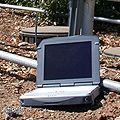


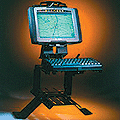





 COM stands for Computer-On-Module and is a type of highly integrated PC commonly used in various embedded systems projects. Unlike regular PC motherboards with their numerous wires and cables and connectors, COM boards simply plug into a project-specific carrier board. In essence, by using COM modules, systems integrators can treat entire computers like mere components and concentrate on the specific aspects of their project instead, saving cost and development time.
COM stands for Computer-On-Module and is a type of highly integrated PC commonly used in various embedded systems projects. Unlike regular PC motherboards with their numerous wires and cables and connectors, COM boards simply plug into a project-specific carrier board. In essence, by using COM modules, systems integrators can treat entire computers like mere components and concentrate on the specific aspects of their project instead, saving cost and development time.
 In terms of performance and features, most current COM Express Mini modules use Intel Atom processors. And as for now, Mini modules are either Type 1 or Type 10 single connector pin-outs (for pin-out details,
In terms of performance and features, most current COM Express Mini modules use Intel Atom processors. And as for now, Mini modules are either Type 1 or Type 10 single connector pin-outs (for pin-out details, 
 As far as performance goes, the small size and intended purpose of COM Express Mini modules go hand-in-hand with the targeted performance and low TDP of Intel Atom processors. And for the SOM-7565, Advantech selected the Atom N2600, which has a lot going for itself as, in our opinion, one of the best overall Atom processors.
As far as performance goes, the small size and intended purpose of COM Express Mini modules go hand-in-hand with the targeted performance and low TDP of Intel Atom processors. And for the SOM-7565, Advantech selected the Atom N2600, which has a lot going for itself as, in our opinion, one of the best overall Atom processors.

